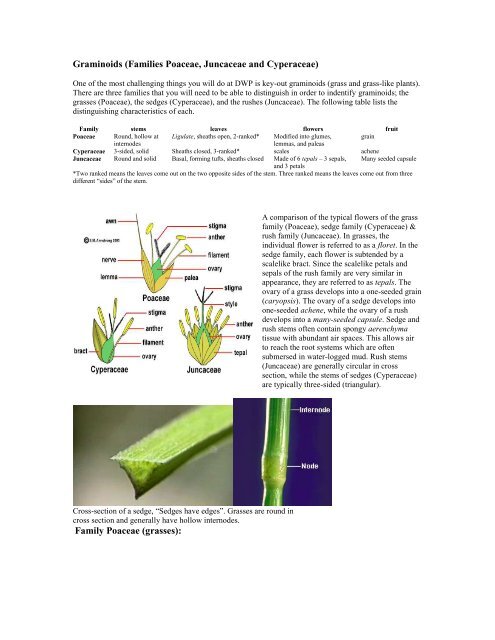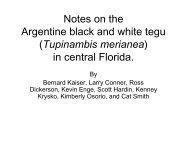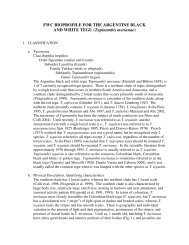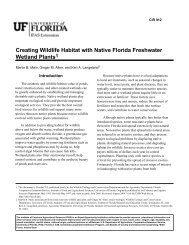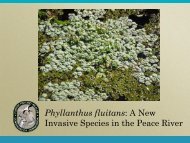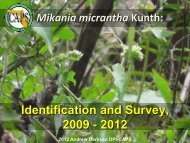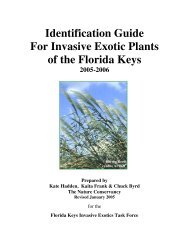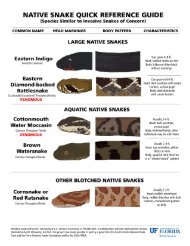Graminoids (Families Poaceae, Juncaceae and Cyperaceae)
Graminoids (Families Poaceae, Juncaceae and Cyperaceae)
Graminoids (Families Poaceae, Juncaceae and Cyperaceae)
Create successful ePaper yourself
Turn your PDF publications into a flip-book with our unique Google optimized e-Paper software.
<strong>Graminoids</strong> (<strong>Families</strong> <strong>Poaceae</strong>, <strong>Juncaceae</strong> <strong>and</strong> <strong>Cyperaceae</strong>)<br />
One of the most challenging things you will do at DWP is key-out graminoids (grass <strong>and</strong> grass-like plants).<br />
There are three families that you will need to be able to distinguish in order to indentify graminoids; the<br />
grasses (<strong>Poaceae</strong>), the sedges (<strong>Cyperaceae</strong>), <strong>and</strong> the rushes (<strong>Juncaceae</strong>). The following table lists the<br />
distinguishing characteristics of each.<br />
Family stems leaves flowers fruit<br />
<strong>Poaceae</strong> Round, hollow at Ligulate, sheaths open, 2-ranked* Modified into glumes, grain<br />
internodes<br />
lemmas, <strong>and</strong> paleas<br />
<strong>Cyperaceae</strong> 3-sided, solid Sheaths closed, 3-ranked* scales achene<br />
<strong>Juncaceae</strong> Round <strong>and</strong> solid Basal, forming tufts, sheaths closed Made of 6 tepals – 3 sepals,<br />
<strong>and</strong> 3 petals<br />
Many seeded capsule<br />
*Two ranked means the leaves come out on the two opposite sides of the stem. Three ranked means the leaves come out from three<br />
different ―sides‖ of the stem.<br />
Cross-section of a sedge, ―Sedges have edges‖. Grasses are round in<br />
cross section <strong>and</strong> generally have hollow internodes.<br />
Family <strong>Poaceae</strong> (grasses):<br />
A comparison of the typical flowers of the grass<br />
family (<strong>Poaceae</strong>), sedge family (<strong>Cyperaceae</strong>) &<br />
rush family (<strong>Juncaceae</strong>). In grasses, the<br />
individual flower is referred to as a floret. In the<br />
sedge family, each flower is subtended by a<br />
scalelike bract. Since the scalelike petals <strong>and</strong><br />
sepals of the rush family are very similar in<br />
appearance, they are referred to as tepals. The<br />
ovary of a grass develops into a one-seeded grain<br />
(caryopsis). The ovary of a sedge develops into<br />
one-seeded achene, while the ovary of a rush<br />
develops into a many-seeded capsule. Sedge <strong>and</strong><br />
rush stems often contain spongy aerenchyma<br />
tissue with abundant air spaces. This allows air<br />
to reach the root systems which are often<br />
submersed in water-logged mud. Rush stems<br />
(<strong>Juncaceae</strong>) are generally circular in cross<br />
section, while the stems of sedges (<strong>Cyperaceae</strong>)<br />
are typically three-sided (triangular).
Awn — a stiff bristle situated at the tip of a glume or lemma.<br />
Collar — the junction of the leaf sheath <strong>and</strong> blade.<br />
Culm — the stem of a grass.<br />
Floret — a single small flower, usually a member of a cluster, such as a spikelet or a head.<br />
Glume — the lowest two (sometimes one) empty scales subtending the usually fertile scales in grass<br />
spikelets.<br />
Lemma — the lowermost of the two scales forming the floret in a grass spikelet -- the uppermost, less<br />
easily seen, is called the palea.<br />
Ligule — an extension, often scarious (papery), of the summit of the leaf sheath.<br />
Nerve — same as a vein. The central vein running lengthwise on a scale<br />
Node — the point along a stem which gives rise to leaves, branches, or inflorescences.<br />
Palea — the uppermost of the two scales forming the floret in a grass spikelet (often obscure or hidden).<br />
Rachilla — a secondary rachis. The axis of a spikelet.<br />
Sheath — a tubular structure effected by the formation of leaf margins around the stem. The base of a grass<br />
leaf that runs from the node up to the blade.<br />
Spikelet — a secondary or small spike; specifically, in the <strong>Poaceae</strong> family, the unit composed or one or two<br />
glumes subtending one to several sets of lemma <strong>and</strong> palea combinations.<br />
Family <strong>Juncaceae</strong> (rushes):<br />
1
Note the perianth segments (sepals <strong>and</strong> petals) in these rush flowers. There are three sepals <strong>and</strong> three petals<br />
that look pretty much alike. Collectively we call them tepals – there are 6 tepals in a rush flower. You will<br />
not find this flower structure in the <strong>Poaceae</strong> or the <strong>Cyperaceae</strong>.<br />
At right is another picture of a rush. This photo<br />
shows the fruit of the rushes, the many seeded<br />
capsule has split open releasing the seeds. This<br />
fruit type is also unique among the three<br />
graminoid families.<br />
2
Family <strong>Cyperaceae</strong> (The sedges):<br />
There are numerous genera within the family <strong>Cyperaceae</strong> that you will encounter at DWP. We will discuss<br />
the family characteristics in general <strong>and</strong> three genera within the family. Examples of sedges, <strong>and</strong> their<br />
flower structure, are shown in the illustration below.<br />
The key to the most common genera of sedges you will encounter at DWP is provided. However, there are<br />
numerous genera not listed in this key that are present at DWP (e.g. Fimbristylis, Fuirena, Bulbostylis,<br />
Dulichium, Kyllinga <strong>and</strong> Scirpus), so use this key with that fact in mind. You will use this key during<br />
exercises designed to familiarize you with this group. A more detailed discussion of Cyperus, Carex <strong>and</strong><br />
Rhynchospora follows.<br />
1 Achene enclosed in a sac (perigynium), with style <strong>and</strong> stigmas protruding through a terminal opening;<br />
flowers unisexual, the staminate flowers either above or below the pistillate in the same or separate<br />
spikelet, leaf blades with a midrib…………………………………………………………………….Carex<br />
1 Achene not enclosed in a perigynum; flowers perfect (except in Scleria, which has exposed <strong>and</strong> bony<br />
white achenes)<br />
2 Florets unisexual; achene exposed <strong>and</strong> with a white, bony-crusty covering……………………….Scleria<br />
2 Florets bisexual; achene enclosed within scales <strong>and</strong> lacking a whitish covering.<br />
3 Scales of spikelets 2-ranked, obviously in 2 rows along the axis, bristles absent, achene 2-3 sided…..<br />
…………………………………………………………………………………………………..Cyperus<br />
3 Scales of spikelets spirally arranged on axis<br />
4 Spikelet solitary, stems leafless except for bladeless sheaths……………………………...Eleocharis<br />
4 Spikelet many, stems leafy……………………………………………………………..Rhynchospora<br />
The genus Carex: As mentioned previously<br />
male (staminate) <strong>and</strong> female (pistillate) flowers<br />
are separate in Carex. They are not always in<br />
entirely different spikes, however. In the photo at<br />
right the stigmas of the female flowers <strong>and</strong><br />
anthers of the male flowers are clearly<br />
distinguishable from one another.<br />
3
This series of photographs clearly shows the papery perigynium that surrounds the achene in this Carex sp.<br />
Note the long protuberance on the achene, which is the remnant of the style (review flower structure if you<br />
need to). The fruit characteristics shown in these photos are unique to this group.<br />
The Genus Cyperus: Besides the solid triangular stem the thing you might notice first about plants in<br />
the genus Cyperus is the distinctly 2-ranked arrangement of the spikes evident in the photographs below.<br />
Note how the individual floral units (spikelets) are clearly arranged along opposite sides of the rachis.<br />
These also tend to be flattened in appearance. Unlike Carex, plants in the genus Cyperus do not have a<br />
perigynium. Within each scale is an achene, shown in the right photo. We will practice identifying these in<br />
the field, so you will become comfortable with distinguishing a scale from a perigynium.<br />
4
The Genus Rhynchospora: Plants in the genus Rhynchospora lack a perigynium, <strong>and</strong> have scales<br />
that are arranged spirally on the axis (A) rather than in the flattened 2-ranked pattern seen in Cyperus. The<br />
fruit type in this group (like that in Carex <strong>and</strong> Cyperus) is the achene (B). The unique appearance of<br />
Rhynchospora achenes will help you recognize these plants in the field. However, these are considered by<br />
some to be one of the more difficult groups of plants to ―field identify‖ to species due to the small size of<br />
the achenes of many species, <strong>and</strong> due to the fact that in order to accurately identify many species the<br />
achenes need to be fully ripe. But like the other challenging groups discussed thus far, with practice one<br />
can achieve some measure of confidence with in identifying these plants.<br />
A B C<br />
5
The achenes in photos B <strong>and</strong> C clearly show some of the characters important for the identification of<br />
Rhynchospora; the beak, perianth bristles, <strong>and</strong> surface features of the achene body. In order to make a<br />
species determination in this group it is essential that these features be clearly visible. This may require<br />
collection of specimens for observation under the dissecting scope. We will spend some time identifying<br />
these in the next few exercises.<br />
Conclusions<br />
Well that’s it. Now you’re an expert! Like anything worthwhile it takes time, patience, <strong>and</strong> practice to<br />
become proficient at plant identification. I think you will be surprised at how many different plant species<br />
you will be able to recognize <strong>and</strong> a plus is that you will probably gain some additional appreciation for the<br />
diversity, <strong>and</strong> intricate beauty of graminoid plants.<br />
References<br />
Websites:<br />
http://www.accessexcellence.org/RC/Ethnobotany/page3.html - good little site on plant classification<br />
http://www.csdl.tamu.edu/FLORA/Wilson/tfp/hdwtfpbs01.htm - link to a plant taxonomy course website.<br />
Good overall taxonomy site, good descriptions of plant families.<br />
http://flora.huh.harvard.edu:8080/actkey/image_key.jsp?setId=100 – excellent plant family key<br />
http://www.geobotany.uaf.edu/teaching/biol474/plant_family_charact.html - guide to plant families<br />
http://arnica.csustan.edu/key/key.html - fantastic online fruit key<br />
http://herba.msu.ru/mirrors/www.helsinki.fi/kmus/botvasc.html - online guide with assorted botanical links<br />
http://www.plantatlas.usf.edu/ - fantastic source on Florida plants from the University of South Florida’s<br />
Institute for Systematic Botany.<br />
http://www.virtualherbarium.org/vh/db/main.php - A virtual herbarium, search for <strong>and</strong> view herbarium<br />
specimens on this site<br />
6


